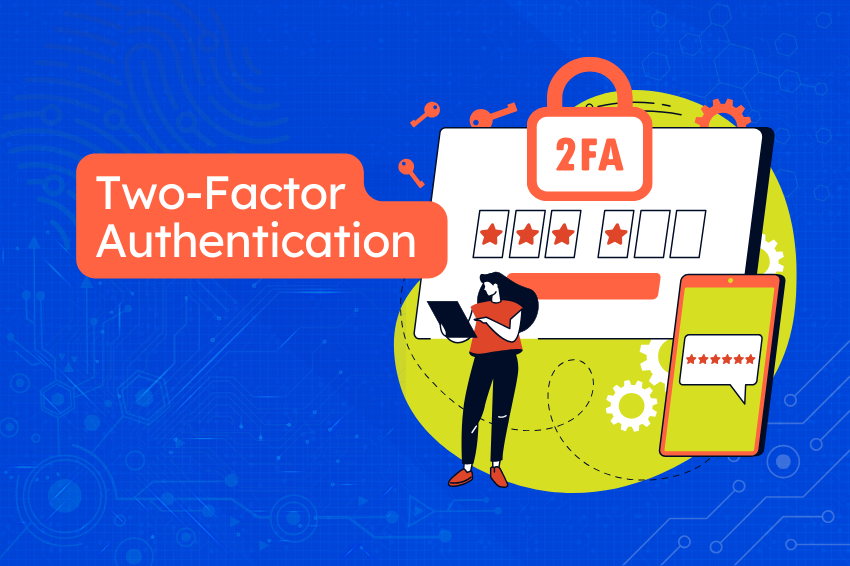An effective security mechanism is very important in securing a business against various threats in the modern world. With organizations going online, there are many openings for hackers to take advantage and attack an organization’s critical information. The implementation of 2FA as a security measure to be taken in any firm is crucial because it helps to prevent unauthorized access, build up trust from clients, employees, and partners in the business.
Here are the steps for successfully implementing 2FA in your business, assessment of its advantages, and some recommendations and suggestions.
Understanding Two-Factor Authentication (2FA)

Two-Factor Authentication (2FA) is a two-step authentic process that is used to ensure a particular online account is being accessed by the right person. Usually, this is an element that the user is aware of, for instance a password and an element that the user possesses such as a cell phone for receiving a code.
2FA also refers to something that belongs to the user, such as fingerprint and other identification details. As it is known, the idea of 2FA is based on the concept of defense in depth. This is brought about by the fact that 2FA seeks to build on the traditional username-password authentication and thus sharpens the potential risk of entrance to the wrong individuals.
Types of 2FA (Two-Factor Authentication)
- SMS based 2FA: This form requires the provision of a one-time code through the user’s mobile phone that he has to type in to be allowed access.
- Authenticator Applications: For example, WhatsApp can use Google Authenticator or Authy to come up with more of the time-based one-time passwords (TOTP) on the user’s mobile device.
- Email based 2FA: It confirms a username and password and sends an email with the second factor to the registered email address which the user must enter.
- Hardware Tokens: These are physical devices that will generate some code for the user to enter so as to be granted access, to confirm their identity.
- Biometric Authentication: They use fingerprints, facial or iris to login accepting user as they are unique to an individual.
- Push Notification: It provides a login request to another device that the user has to authenticate to access.
- Voice or Call Verification: It involves the last step where the user has to answer an incoming call or listen to a recorded message with a verification code.
- Security Keys: Physical objects that include USB or NFC that the user has to insert or tap for instance FIDO2.
- Geographical 2FA: Gives user geographical location as an attribute, allowing login to take place only from certain locations.
- Single Sign-On (SSO) with 2FA: Users that possess a single account from an SSO provider can use that single account to access multiple applications while further security at the second factor is incorporated.
Key Benefits of Implementing 2FA
Enhanced Security
The main advantage of 2FA is the multiple instances of account protection that can occur because of the use of this system. The usage of the password authentications is imminent to several forms of attacks such as, phishing, brute force, and reuse attacks. In as much as passwords can be very hard, the administrators can be bypassed through malware or data breaches getting the login credentials. 2FA makes it many times harder for the attackers to get past the initial layers of defense mechanisms.
Protection Against Phishing Attacks
Phishing is another form of web attack, which is used widely by cyber criminals to gain the consent of individuals to release their login credentials. In 2FA system, the attacker is tricked into getting the user’s login credentials through phishing techniques, the hacker cannot log into the account because they do not possess the 2FA. This extra layer greatly minimizes the possibilities of the attack, making it rather difficult for the attackers to execute the phishing attack.
Mitigation of Credential Theft
One of the most common themes in the contemporary cyberspace is the theft of an account’s login details. These may be rooted in keylogging, through which malware stores and tracks the keys that are pressed in order to catch passwords, or in obtaining data theft lists with stolen credentials. By implementing the 2FA solution organizations and individuals are able to minimize much of the effects of credential theft. In case an attacker gains a user’s password, the second factor provides a sufficient safeguard against unauthorized access.
Reduction of Unauthorized Access
This alerts a user if their account has been compromised since the user must verify the second method of identification to make purchases. This result in putting forward the assurance that even if the attacker got the first factor to the user’s profile, they will require the second factor in order to gain access to the account and the associated sensitive information.
Increased User Trust and Confidence
2FA can improve the users’ confidence and trust in the systems. Thus, customers are aware of the potential threats in cyberspace and value companies’ actions that protect their information. By extending the usage of 2FA, organizations prove that they pay attention to the details of the user data and, therefore, the users choose to remain loyal to such organizations hence enhancing on its market reputation.
Compliance with Regulatory Requirements
Several sectors have legal guidelines on the protection of data and cybersecurity that ought to be followed. Many legal frameworks can be found, such as GDPR, HIPAA and the PCI DSS, that often demand strong security measures, often in the form of 2FA. The use of 2FA would be of significant importance in ensuring that the organizations do not fall foul of the legal departments on matters concerning these regulations hence preventing any legal implication of being fined.
Protection of Sensitive Information
The data such as financial details, personal identification number, and other organizational and personal sensitive information must be protected at all levels. The use of 2FA adds a layer of security that only the persons authorized can access accounts containing such information. This is especially the case given that such information is highly sensitive and often concerns clients of those organizations, for instance, in the financial and health sectors.
Prevention Against Cyber Attacks
In even with the mere presence of a 2FA factor, it will be able to reduce the lib of some attackers. The fact that there is another line of defense is put in place may prevent a hacker from trying to penetrate an account. This deterrent effect can decrease the total amount of attacks, as attackers can employ themselves to go towards the systems that appear to have fewer and weaker defense measures.
Flexibility and Customization
Thus, 2FA adaptation allows for flexibility and the ability to adjust and deploy depending on the security requirements. Second-factor methods available for use by organizations include, code by SMS, authentication apps, tokens, and biometric scan. Such flexibility will enable the defined security measures to respond to the security needs of an organization and the user’s preferred means.
Improved Incident Response
When some account has been compromised, the author mentioned that utilizing 2FA has a great impact on the incident handling process. Due to the fact that it involves using two-factor for logging in into the system, 2FA act as a check point to prevent unauthorized access. This can help in faster detection of such accounts, which is followed by immediate addressing of the issue and therefore reduction on the possible losses.
Enhanced Protection for Remote Work
As more individuals are embracing works from home employment, they are using internet-based solutions, thus opening up the aspect of cyber security. 2FA is crucial in the new way of working mainly due to the use of multiple devices to access sensitive data. In this way, as 2FA demands at least an additional form of authentication, the access to different resources from remote locations will be safe and its employees will be defended from threats.
Cost-Effectiveness
Before using 2FA, there are certain costs that are required to be incurred but overall, 2FA is a cost-effective security feature. The price which may be paid for a data breach in terms of financial losses, legal expenses, and loss of reputation is much higher than the cost associated with implementing 2FA. Due to the following, 2FA is likely to cost organizations a significant of money in the long run through protection against the above effects of data breaches.
Planning Your 2FA Implementation
Careful planning must be made before embedding the 2FA to any organization since the implementation process takes time and requires adjustment with other security features that are already in place. Here’s how to get started:
Assess Your Current Security Infrastructure
Conduct a security check to establish your starting point or the current security situation The individuals should ensure that they engage a security audit to identify the security situation so that they know where they are beginning from. List all systems and data that necessary to protect and assess how 2FA can be adopted within security framework.
Identify Stakeholders
Create the cross-functional team and/or work groups of IT, security, HR, and departmental managers within the organization so that all needs and constraints are understood by all parties.
Choose the Right 2FA Solution
Identify and choose the 2FA solution that can effectively cater to the size of an organization, complexity of the organization, as well as the overall necessities of the organization. It is crucial to take into consideration compatibility with the current systems, its usability, simplicity of expansion, and vendor support.
Develop a Rollout Plan
Develop a work plan that should indicate the steps that need to be undertaken for the 2FA implementation process to be accomplished in stages. This should capture timeframes, resources, and roles and responsibilities as well as a plan for dissemination of change across the employees as well as other stakeholders.
Provide Training and Support
Now, reinforce 2FA as an organization and train your employees about its use and the reasons for that. follow up as a way of responding to any queries that may be anticipated or any complications that may arise during and after the program.
Implementing 2FA in Your Business
Choose a 2FA Provider
To do so, one should select a 2FA provider aligned to his or her business needs. Some popular options include:
- Authy: It offers cloud synchronization and backup options.
- Google Authenticator: An output from Google that is one of the most popular applications for using TOTP.
- Duo Security: It is a security company offering various solutions that include 2FA.
- Okta: It offers identity management solutions with 2FA integration.
Integrate 2FA with Your Systems
This will again depend with the type of system you have and the type of 2FA method adopted. Here are general steps:
- APIs: Most 2FA providers offer APIs for customers to integrate into their apps. Discuss with the IT department on how they can be incorporated with the current systems.
- SSO Compatibility: It is also important that the implemented 2FA solution is compatible with the current Single Sign-On (SSO), if any exists.
- Brand it 2FA: Brand and tweak the application’s 2FA to match the specific needs and experience you wish for your clients.
Configure 2FA Settings
- Enrollment: User enrollment process should be simple in order to engage 2FA. There should be a simple registration of devices and login into their accounts.
- Backup Options: This feature will offer an ability for the users to give a backup for the other 2FA method in case one of them is lost. This could also involve the backup codes or any other form of suffixes for the usage of authentication.
- Security Policies: Set up strong such security policies as mandatory, for example, 2FA to access some data or systems.
Test the Implementation
- Functional Testing: Conformance check of 2FA system to determine if they perform as designed in various devices or platform.
- User Acceptance Testing (UAT): Allowed users to test the system to ensure that the product effectively fulfils the user requirements thus creating a positive user experience.
- Security Testing: There should be a security test to be conducted with a view of testing the 2FA for security weaknesses.
Monitor and Maintain
- Maintenance: For 2FA to operate efficiently and for compliance to the security policies, conduct audits frequently to identify and solve any problems that might have arisen.
- User Feedback: It is essential to solicit feedback from the users to know their concerns and complaints, which need to be resolved quickly.
- Update and Patch: Ensure that the 2FA system and all future related software are updated from security vulnerabilities.
Best Practices for Implementing 2FA
- User Education: Users constantly look for the existence of 2FA and different authentication methods of protection such as not sharing the code with others and timely update of the applications.
- Frequency: Make it a best practice to keep track of the current trends in security threats and adapt the 2FA policies to these trends. Allow the users to make contributions based on their opinion towards the process to enhance it.
- Usability: Despite the complexity or the relative sophistication of the 2FA process, steps should be taken to make it friendly enough so that none of the employees are inclined towards rejecting it.
- Secondary Authentication: Always have a secondary mode of authentication to avoid such mishaps and maintain the normal flow of the business.
- Test Regularly: They should occasionally perform exercises to ensure that the 2FA system works well as well as all the users understand how to use it.
Challenges and Considerations
The adoption of 2FA indeed come with many advantages, however it has been established that there are challenges as well together with factors that one will have to consider at the time of 2FA implementation.
User Convenience
The main drawback of the 2FA is to strike a balance between security and ease of use from the client’s side. Some of the users may feel that the further authentication is causing inconvenience is leading to irritation and low satisfaction levels among the users. In this regard, organizations should integrate effective communication that educates the users on the importance of 2FA as well as recommend ways that would enable the efficient application of the practice.
Implementation Costs
Thus, cost can comprise of expenditure on software or hardware or even personnel for training on the use of 2FA. There are many solutions to formulate a selection criterion and its effectiveness: organizations’ needs and budget should be taken into consideration in order to find the most appropriate solution of the 2FA. There are several affordable solutions which make 2FA easily implementable in businesses of every level.
Backup and Recovery
In the case a person is not able to access the second-factor device, there is need to have a backup and recovery strategy need to be in place. There should be standard measures to help users regain their account since this will prevent unauthorized individuals from gaining access to the accounts.
Continuous Evaluation and Improvement
This is important due to the ever-growing threats in the cyberspace that call for frequent measures to strengthen the existing approaches to 2FA. Policies should be updated from time to time, security checks must be conducted frequently, users must be up to date with the current threats, which will help to make the 2FA functional.
Conclusion
Implementing 2FA is a wise business decision that guarantees the improvement of your security level and the level of trust of your clients. Incorporating another form of authentication is beneficial in ensuring your company’s crucial information and showing that efforts towards the security standards are being made. It is thus advisable to consider how to go about the implementation of 2FA for the security of data by following these fundamental steps for its integration as a strategic security control: Popular among both individuals and organizations, 2FA will remain an important factor as long as threats on the online stage are proliferating, thus protecting the future of your business.


